In case of an injury inflicted by an accident or by any other means, there is a possibility of bone fracture, bone dislocation, or laceration along with a ruptured ligament or tendons, etc. In all of these cases, it is necessary to keep the affected area rigid to avoid further damage and speed up the process of healing. Here, the splints come in handy as they are particularly designed to serve this purpose.
What is a splint?
A splint is an artificial support that is provided to the fractured area with the aim to keep it immobilized until recovery. The application of these splints is termed ‘splinting. These are available in different sizes and shapes. Splints are rigid in nature and are made up of metal, wood, or plastic.
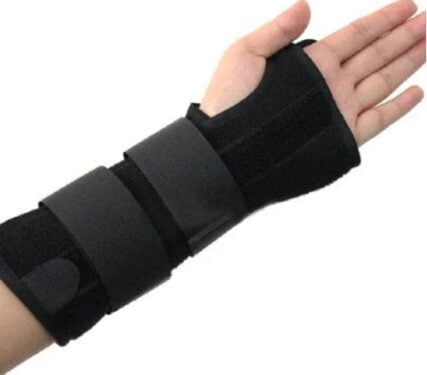
Hand wrist splint
Why are splints applied?
The splints are applied as first-line therapy in case of an injury to serve the following functions:
- To immobilize the injured body part to speed up the healing
- To decrease the pain which is caused by movement
- To alleviate inflammation over time
- To restrict the affected part to prevent collateral damage to the nearby muscles
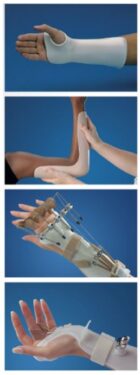
Different types of splints
Who needs a splint?
In any of the following cases, the patient may require splinting in order to immobilize the injured or traumatized area:
- Sprains i.e. injury to the ligaments
- Strains i.e. injury to the tendons
- Fractured bones
- Dislocated bones
- Ruptured tendons
- Soft tissue injuries
- Carpal tunnel syndrome (CTS) i.e. a condition in which the wrist nerves are pressurized causing tingling, pain, and numbness.
Types of splints
The splints are divided into 4 categories:
- Static splints: A static splint, as the name suggests, is a non-mobile plank-like structure that almost completely restricts the movement of the injured area. Its actions fall in the domains of supportive as well as corrective and protective. A common example of this type of splint is the wrist splint.
- Dynamic splints: A dynamic splint, apart from providing ample support to the injured site, also allows a limited amount of movement. It enables the physicians to adjust the splint over time and allows the patient to use the affected body part more and more until it becomes fully healed and functional.
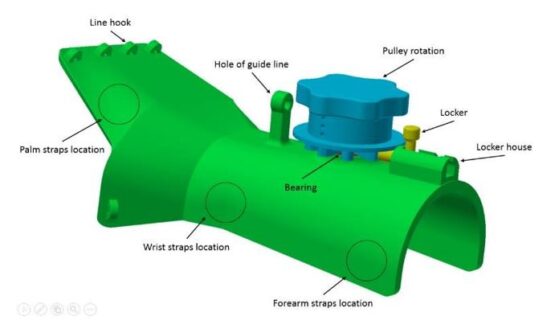
3D model of a dynamic wrist splint
- Serial static splints: Serial static splints, just like the dynamic type, allow movement and are thus preferable by the patients as well as by the physicians. These are particularly designed to extend the soft tissues to such an extent that their available range is reached. This is helpful if an increase in the tissue length is aimed.
- Static progressive splints: The static progressive splints are attached to an inelastic component with the aim to apply torque to a joint. It is done to position the joint as close to the end range as possible. This way, the passive range of motion is maximized.
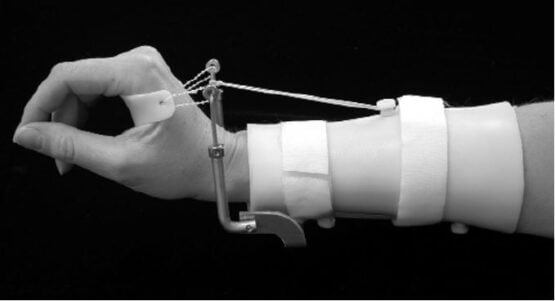
Static progressive splint for the wrist
A comparison of all four types of splints can be seen in the following diagram:
Selecting the right splint
The splints are available in different shapes and sizes and can be chosen based on the severity of the trauma at the site of injury. With variations in the type of injury, the suitability of the type of splint also changes. Here is a simple guide to choosing the right splint according to the condition at hand:
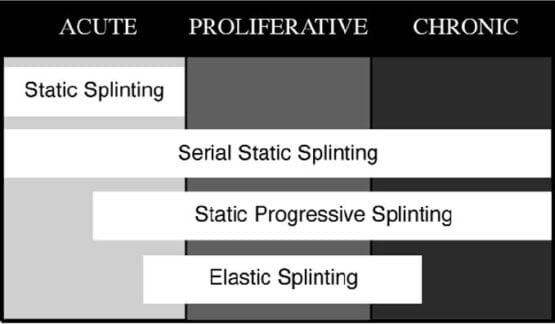
Ideal splint based on the severity of the injury
Demerits of splinting
The only demerit of splinting is that once recommended by the physician, it is further the patient’s own responsibility to wear it every day. Sometimes, the patients forget to wear them or are too uneasy to keep them on thus rendering the recovery slower.
Problems associated with the long-term use of splints
Although there are no side effects associated directly with the splints, their long-term use may cause any of the following issues:
- The appearance of pressure sores on the affected area
- Numbness or tingling in the affected area
- Constant sensation of burning
- Inflammation on the area which is below the splint
- Muscular modifications at the site
- Changes in the skin texture and color
- Development of infections or dermatitis
In case of the presence of any of the above-mentioned conditions, it is advised to report to your physician.
Taking care of a splint
To avoid the above-listed complications, it is advised to often remove and clean the splints. In this regard, keep in mind the following measures:
- Avoid moisture: Moisture, when in contact with the material of the splint, can cause dampness which may result in irritation of the skin. To avoid this issue, it is necessary to keep the splint dry. Use a waterproof shield or plastic to cover the splint while taking a shower.
- Avoid dirt: It is recommended to clean the splint frequently and keep it free from dirt or sand.
- Do not rub the splinted area: It is not recommended to poke the splinted area in case of itching or irritation. Avoid using any medication, power, or deodorant on the affected site. If the itching persists, contact your physician.
Conclusion
Splints are rigid devices designed to provide support to the body parts which are affected by an injury. This way, the damaged area is restricted to moving thus maximum rest is provided to facilitate healing and recovery. Their availability in different types and sizes further increases their demand and application. With changing types, the functionality of a splint is also changed. Some of its types are applied merely for the restriction of motility while others are also beneficial for muscle length extension. Moreover, they are easy to wear and remove. Due to these characteristics, splints are preferred overcasts.

PhD Scholar (Pharmaceutics), MPhil (Pharmaceutics), Pharm D, B. Sc.
Uzma Zafar is a dedicated and highly motivated pharmaceutical professional currently pursuing her PhD in Pharmaceutics at the Punjab University College of Pharmacy, University of the Punjab. With a comprehensive academic and research background, Uzma has consistently excelled in her studies, securing first division throughout her educational journey.
Uzma’s passion for the pharmaceutical field is evident from her active engagement during her Doctor of Pharmacy (Pharm.D) program, where she not only mastered industrial techniques and clinical case studies but also delved into marketing strategies and management skills.
Throughout her career, Uzma has actively contributed to the pharmaceutical sciences, with specific research on suspension formulation and Hepatitis C risk factors and side effects. Additionally, Uzma has lent her expertise to review and fact-check articles for the Health Supply 770 blog, ensuring the accuracy and reliability of the information presented.
As she continues her PhD, expected to complete in 2025, Uzma is eager to contribute further to the field by combining her deep knowledge of pharmaceutics with real-world applications to meet global professional standards and challenges.








